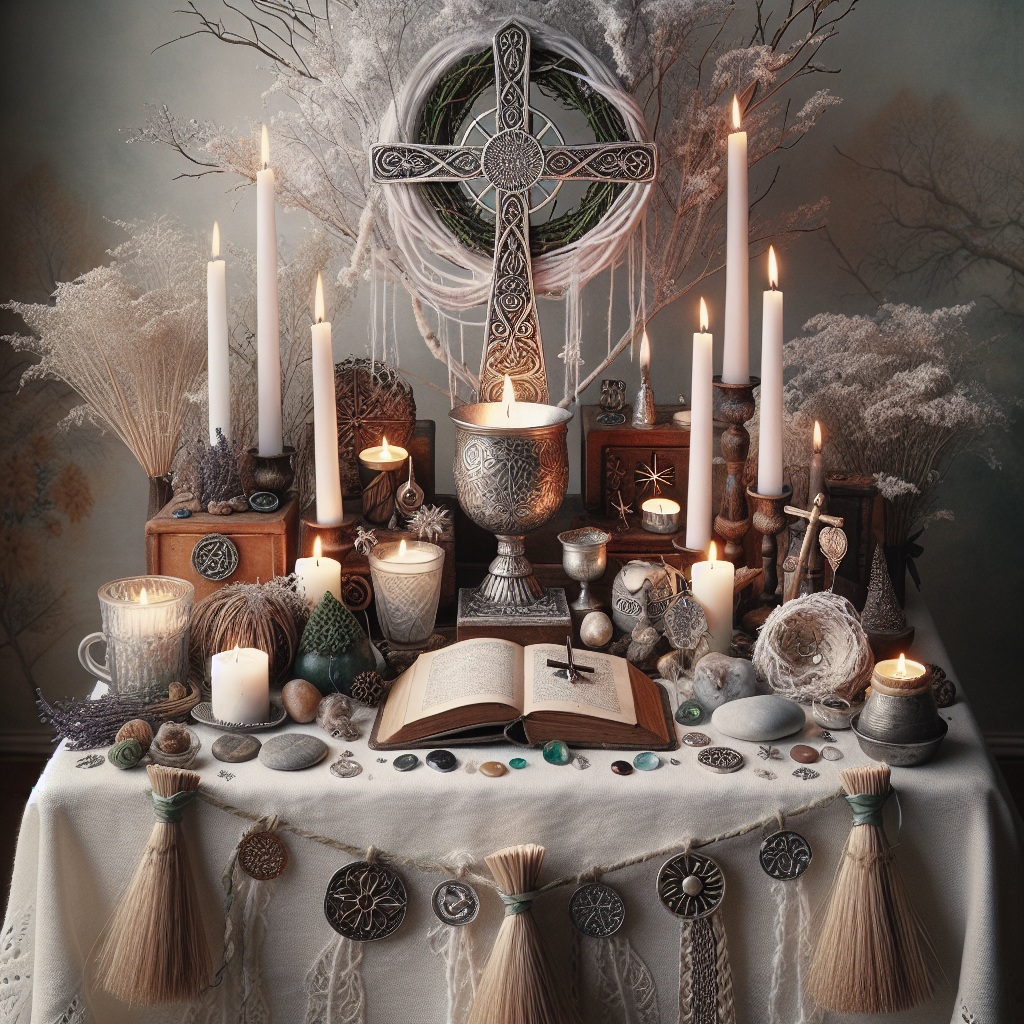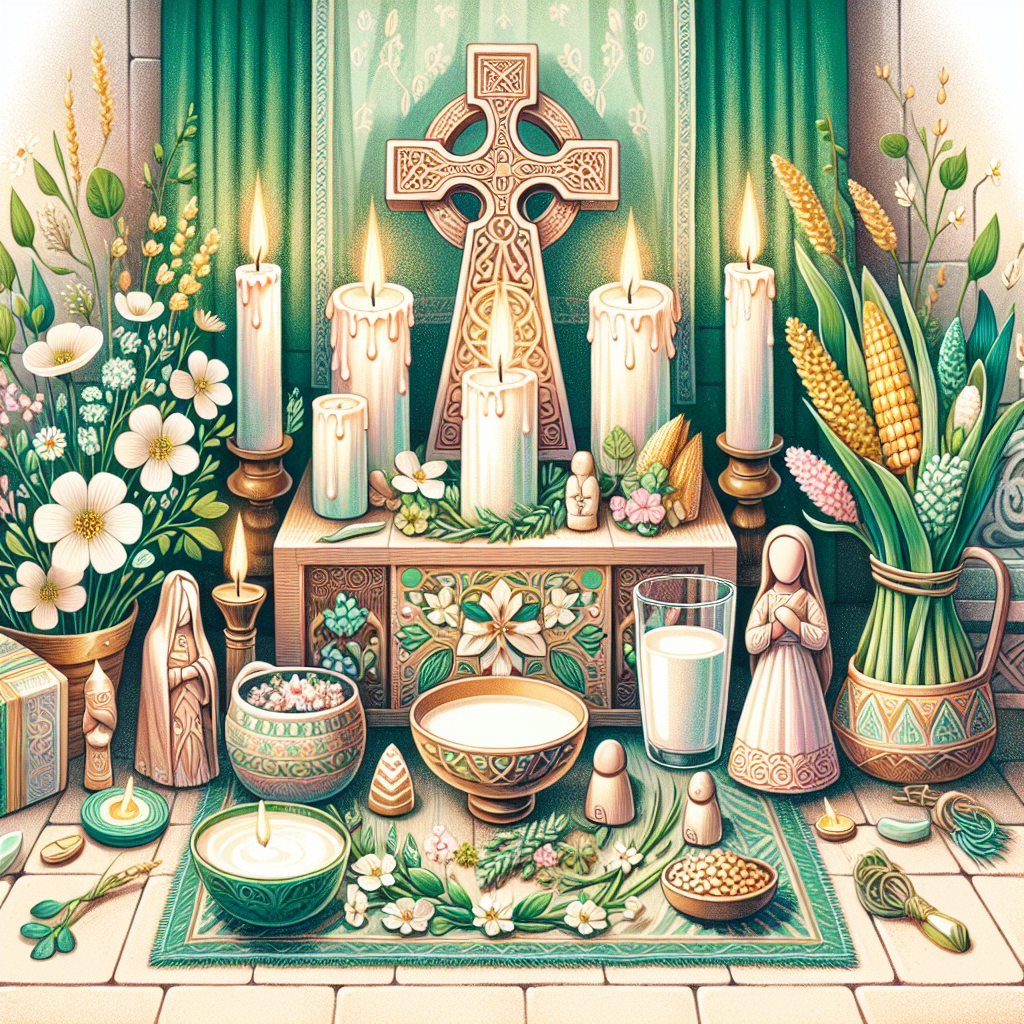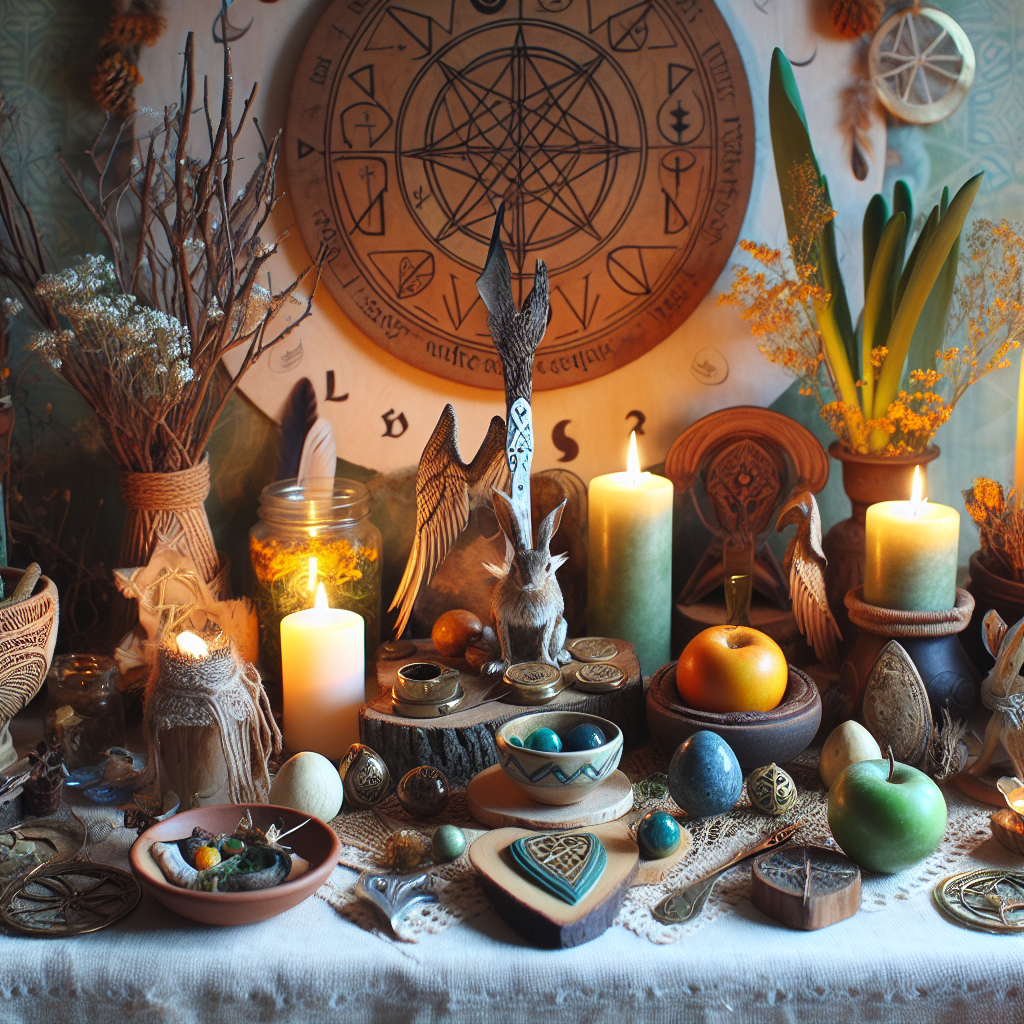As an Amazon Associate I earn from qualifying purchases.

Imbolc, celebrated on February 1st and 2nd, marks the halfway point between the winter solstice and the spring equinox in the Celtic tradition. This festival, one of the four principal Celtic seasonal festivals, is often associated with the goddess Brigid and symbolizes the awakening of the earth as it prepares to burst into spring. The imbolc altar, therefore, serves as a focal point for honor, reflection, and celebration of the coming light and life.
The creation of an imbolc altar draws on ancient customs, integrating symbols of fertility, purification, and renewal. Traditionally, these altars feature an array of natural elements and are designed to evoke the promise of the coming spring. Elements like candles and white flowers echo the purity of snow and the first signs of new growth, while seeds and greenery symbolize the potential of the earth to regenerate. The lighting of candles specifically holds a place of importance, as it represents the return of light after the dark winter months, and is a common practice to honor the Celtic goddess Brigid, who is often associated with the hearth and home.
A compelling aspect of imbolc altars is their blend of personal and traditional decorations. Many practitioners like to include a Brigid’s cross, which is a woven figure made from rushes or straw, believed to protect homes from harm. Additionally, it’s common to place a small bowl of water on the altar, symbolizing the element of water for purification and reflection. Statuettes or images of lambs can be included as well, signifying the lambing season which Imbolc heralds.
The arrangements on an imbolc altar often contain a vibrant array of jubilant decorations, with colors like white, red, and green prevailing; white for purity and newness, red for the strengthening sun, and green representing the awakening life in the natural world. It’s a practice rich in joy and anticipation, much like the season it celebrates. Embellishments such as ribbons and seasonal flowers add a personal touch, while crystals like amethyst for peace or citrine for renewed energy might also find their place among the decorations.
The power of the imbolc altar as a centerpiece for this time of year can be quantified by its enduring popularity. It is estimated that thousands of pagans and neo-pagans worldwide continue to embrace this tradition annually. The altar serves not just as a celebration of spring, but also as a spiritual tool for setting intentions for the year ahead. It is a practice deeply intertwined with the natural cycles of the earth, speaking both to the ancient roots of human agrarian societies and the contemporary yearning for connection with the cycles of nature.
“`html
What Are the Best Decorations for an Imbolc Altar to Celebrate the Season?
“`
Imbolc is an ancient Celtic festival marking the beginning of spring and is traditionally celebrated on February 1st. It’s a time for purifying and lighting fires symbolically to welcome the returning warmth and the increasing light. Decorations for an Imbolc altar typically include candles to represent the sun’s warmth, Brigid’s crosses as a nod to the goddess associated with the festival, and greenery to symbolize new growth. Symbols of fertility, such as seeds and horns, may also feature, along with items representing purification like white flowers or a bowl of milk. For those seeking to create a jubilant and appropriate display for Imbolc, incorporating these elements not only honors the tradition but also aligns with the themes of renewal, purification, and light. Dive deeper into the specific recommendations and how to arrange your own altar as we continue to explore the joyful adornments conducive to an Imbolc celebration.
Imbolc Altar Decorations serve as vibrant expressions of hope and renewal as we transition from the dark of winter to the promising light of spring. Imbolc, typically celebrated around February 1st or 2nd, is a festival marking the beginning of spring in the Celtic calendar, and it’s a time for honoring the goddess Brigid and the returning warmth of the sun. Incorporating specific, jubilant decorations on an altar can create a focal point for this celebratory season of fertility and purification.
Candles are fundamental in imbuing the altar with the essence of light and warmth that is central to Imbolc. White candles are often selected to symbolize purity and the fresh blanket of snow outside, while red and orange candles can represent the rekindled fire of the sun. Arranging them in a circle creates a warm and inviting atmosphere, reminding us of the growing power of light over darkness.
Brigid’s Cross is another emblematic decoration. Traditionally made from reeds or rushes, it is said to protect homes from harm and evil. Placing this cross on your altar not only pays homage to the goddess but also brings a sense of protection and guidance during this transitional period.
Spring flowers also have their place as jubilant decorations, with snowdrops being particularly associated with Imbolc for their ability to bloom even in the snow, symbolizing resilience and hope. Brightly colored blossoms like crocuses or daffodils can evoke the colorful tapestry of the season ahead.
To represent the fertility aspect of the festival, seeds and nuts can be scattered on the altar. These signify the potential of the upcoming year and the promise of new growth. Some may also choose to include a small bowl of milk as a nod to the lambing season and as an offering to the goddess Brigid, who is closely associated with dairy.
Crystals and stones can add an energetic dimension to an altar. Amethyst, with its soothing and purifying qualities, is particularly fitting for a time of reflection and renewal. Clear quartz, known as a “master healer,” is another excellent choice to amplify the intentions set during Imbolc.
Lastly, including a representation of a lamb or ewe on the altar honors the agricultural roots of the festival and symbolizes birth and the nurturing energies of the season. These can be small statues, illustrations, or even woolen fibers to connect with the element of nature.
In crafting a beautiful and meaningful Imbolc altar, these jubilant decorations not only brighten the space but also serve to align practitioners with the season’s themes of rebirth and renewal.
To provide a statistic acknowledging the significance of Imbolc decorations, a survey by the Pagan Federation found that 70% of practitioners incorporate natural elements into their Imbolc altars, demonstrating the important role that decor plays in embodying the essence of this joyful festival.
1. What is Imbolc and why do people create altars for it?
Imbolc is a traditional Gaelic festival marking the beginning of spring, usually celebrated from February 1st to 2nd. It is a time of awakening and renewal where people create altars to honor the goddess Brigid and the return of light, symbolizing new beginnings and the promise of growth.
2. What are some essential items to include on an Imbolc altar?
Essential items for an Imbolc altar can include candles to represent the returning light, a Brigid’s cross or representation of the goddess Brigid, white flowers for purity, and seeds to signify the potential for new growth. Additionally, incorporating the colors white, red, and green can reflect traditional Imbolc themes.
3. Can I personalize my Imbolc altar with items that are not traditionally associated with the festival?
Absolutely. While traditional elements can provide a connection to the festival’s roots, personalizing your altar with items that have meaningful significance to you can enhance your individual experience and make your celebration more intimate and unique.
4. How do I properly dispose of items from my Imbolc altar once the festival is over?
When disposing of biodegradable items like flowers or food offerings, consider returning them to the earth by burying them or leaving them outside for wildlife. For other items, cleanse them if you wish to reuse them, or donate/recycle them respectfully if they will not be part of your altar next year.
5. What colors are best to use in my Imbolc altar decorations?
The most appropriate colors for Imbolc are white, symbolizing purity and snow; green, representing new life and growth; and red, which signifies the newly returning warmth of the sun. Utilizing these colors can help to evoke the energies of Imbolc.
6. Are there any specific rituals or prayers I should perform when creating my Imbolc altar?
While there are no set rules, many people conduct a ritual to bless their altar, inviting the goddess Brigid for protection and blessings. Reciting prayers, lighting candles, and offering personal intentions for the season are common practices during altar preparation.
7. Is it okay to leave my Imbolc altar up for an extended period, or should it only be for the duration of the festival?
There is no strict rule for how long you should keep your altar up; some choose to leave it up throughout the entire season of spring as a reminder of their intentions and the themes of Imbolc, while others take it down after the festival. Follow your intuition and personal preference.
8. What is the significance of candles on an Imbolc altar?
Candles are a central element of Imbolc altars, symbolizing the return of light as the days begin to grow longer after winter’s darkness. They are also a way to honor the fire aspect of the goddess Brigid and to bring warmth to the celebration.
9. How can I make my Imbolc altar more interactive or experiential?
To create a more interactive Imbolc altar, you can include elements that engage the senses, incorporate activities like writing intentions on paper to place on the altar, use scented oils or incense for smell, and include tactile elements like crystals or textiles that invite touch.
10. Should I involve my family or community in creating an Imbolc altar, or is it a personal practice?
An Imbolc altar can be both a personal practice and a community activity. It can be quite meaningful to involve family or community members in the creation and blessing of the altar, as this can foster a sense of togetherness and shared intent for the coming season.

Concluding Thoughts on Imbolc Altar Decorations
Imbolc Altar Decorations play a significant role in honoring the transition from winter to spring, capturing the essence of rebirth and purification inherent in the Imbolc festival. Essential elements such as candles, representing the return of the light, and white and yellow flowers symbolizing purity and the first stirrings of spring, are stalwarts of these jubilant displays. Incorporating Brigid’s cross and a Brigid doll pays homage to the goddess Brigid, who is central to the celebration, offering protection and blessings for the upcoming agricultural year. Symbols of fertility like seeds and green ribbons also enrich the altar’s significance, invoking the burgeoning life force poised to awaken within the earth.
Our favorite jubilant decorations for Imbolc Altars include the creative use of seasonal greenery and the thoughtful integration of personal totems that resonate with the festival’s themes. By including crystals like amethyst for tranquility and insight, or garnet for warmth and devotion, practitioners further align themselves with the festive energies of Imbolc. Let’s not forget the significance of the hearth—a central feature for many during Imbolc, and therefore candles and fires are especially apt in representing hearth fires. In essence, the altar serves as a sacred space for reflection, intention-setting, and a reminder of the balance between light and dark, warmth and cold, and the cyclical nature of the seasons and life itself.
Amazon and the Amazon logo are trademarks of Amazon.com, Inc, or its affiliates.


